It was a bet: to entrust an entirely French troupe with the Cosi fan tutte of Mozart and to an Emmanuelle Haïm, more specialist in an older repertoire (Handel, Purcell) the direction of the work. Successful bet. But Laurent Pelly’s staging sometimes left us perplexed.
Perplexed…
Puzzled, and we weren’t the only one to judge by the loud applause that greeted the singers and the conductor, applause mixed with boos when the director appeared. A little unfair boos too because if Pelly surprises us with what he has imagined, he always turns out to be a remarkable director of actors – and especially in an opera like Cosi fan tutte where psychology is so important, perfectly followed by singers who show real team spirit. But here it is: we know it, this opera audience (and we include our fellow critics and ourselves too, sometimes), who are interested first of all in the voices, in the sing well, and who has still too often remained at the look like a potted plant as long as you get your high C right.
The “ballet” of the Albanians (Florian Sempey, Cyrille Dubois) C) Vincent Pontet
Are all women fickle?
We also have to confess something (and we’re a little ashamed to say it!): we’re still not convinced that, from a dramaturgical point of view, Cosi fan tutte or an operatic perfection. Three hours of music, from which we would gladly remove half an hour: final work of the “Da Ponte trilogy” (this abbot who composed the libretto of the three masterpieces in Italian) after The Marriage of Figaro (1786) and Don Giovanni (1787), Cosi fan tutte premiered in Vienna at the beginning of 1790; Mozart who has less than two years to live will write again the following year The clemency of Titus (in Italian but not to a libretto by Da Ponte) and The magic flute (in German) But this Cosi-there suffers a little (in our humble opinion) from Da Ponte’s difficulty in tying and above all untying in a clear way the threads of his story with, if we keep a cool head (that is to say if the we forget the splendor of the music), scenes that are repeated, implausibilities that all go to the service of a demonstration: to show, and to demonstrate, that women are fickle and that these are, as they all do (cosi fan tutte), forgetful of their lovers as soon as their backs are turned.
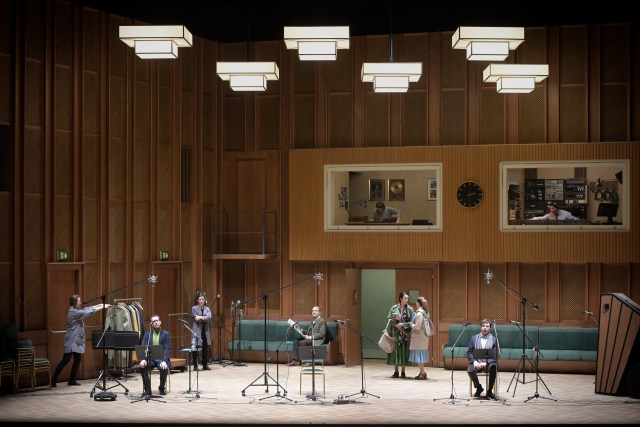
The “Berlin” studio C) Vincent Pontet
New Mozart accents
It would seem that Beethoven, moreover, did not like the work very much because of its too schematic character for him. Of course implausibilities exist elsewhere in operas but this one wants to be as close as possible to the psychology of the characters (eyeing, did Mozart think about it? on the side of Marivaux or Goldoni) and it exists in the directed by Pelly. On the other hand, compensating for these defects, there is this splendid music where Mozart still finds new accents, compared, for example, to the Marriage of Figaro, splendid too but which brings together a collection of admirable tunes. There is really in cosi than a melody that we will hum until we are no longer thirsty, the Soave il vento, trio of the two sisters seeing their lovers disappear and Don Alfonso, the person responsible for the amorous machination that will lose them: overwhelming moment of sweetness and melancholy that grips your heart.
A happy drama
For the rest therefore, the magic of this music lies in the fact that Mozart is able, within the same tableau, to pass in three notes of a form of comedy-comedy-pursuit where the doors slam, and ‘elsewhere Cosi fan tutte is a “joyful drama” (dramma giocoso)- to an infinite sadness, especially concentrated in the characters of Fiordiligi (Vannina Santoni) and Ferrando (Cyrille Dubois) This variety of styles tightened in the music itself makes all the value of the work and, in this Italian trilogy, a Mozart still to where, unlike Marriage of Figaro and to Don Giovanni, a social content does not appear, even if it is the servant Despina who partly pulls the strings of the plot.
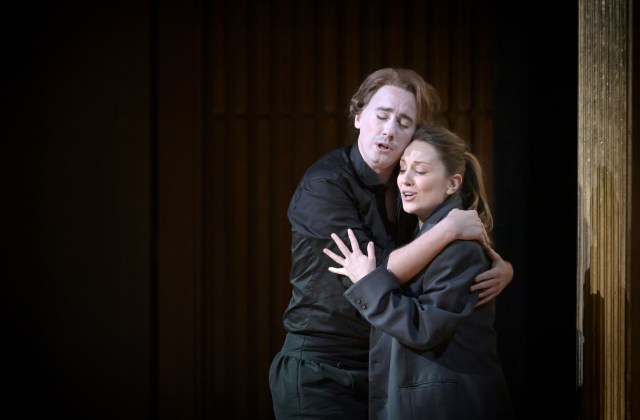
Tender duet of Ferrando-Sempronio (Cyrille Dubois) and Fiordiligi (Vannina Santoni) C) Vincent Pontet
Let’s quickly sum it up: Don Alfonso, a man who has lived, income from everything, wants to prove to his two friends, Ferrando and Guglielmo, engaged to two sisters, Fiordiligi and Dorabella, that they will forget them as soon as they will be gone. So they pretend to go to war (despair of the two sisters) to better come back disguised as Albanians… Obviously, Alfonso will achieve his ends, helped by the servant of the sisters.
A Berlin recording studio!
Laurent Pelly strangely places the plot (according to Mozart and Da Ponte located in Naples, flooded with sun and moon) in a large Soviet-style studio (which exists, it seems, in Berlin, but Nazi totalitarianism had the same architecture than the Stalinist order) where singers (with microphones, recording bubbles, technicians in gray coats) are preparing to record cosi. We are probably just after the war judging by the cut of the dresses, Dorabella in a form new look of the most beautiful green and Fiordiligi in blue. The idea being that little by little the singers invest so much in their characters that they become them in life…
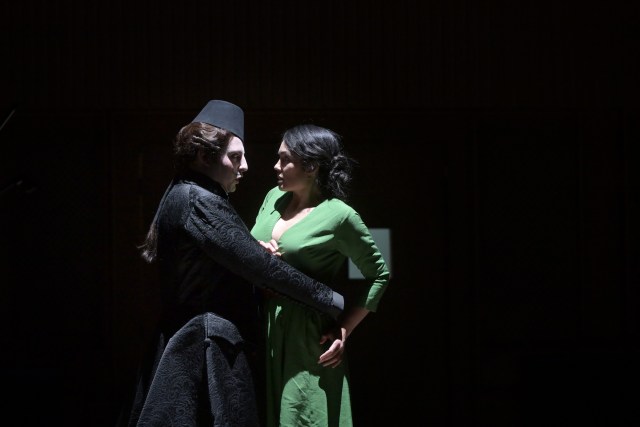
Meeting of Guglielmo-Tizio (Florian Sempey) and Dorabella (Gaëlle Arquez) C) Vincent Pontet
It’s an idea that is worth another but that a Pelly, who has so often dazzled us, does not manage to energize, crushed by its very decor which reduces its scope. Moreover, he is embarrassed by this end which, at the time of weather, leaves a little confused. Now it would have been possible to build, on this field of emotional ruins, a bitterness, a melancholy à la Marivaux, which we nevertheless feel in the two characters quoted and their tunes, the Per pieta, ben mio of Fiordiligi or the Ah! lo veggio! by Guglielmo.
Remarkable direction… of singers
But Pelly is still a master in the way he organizes the circulation of his singers with a precision, a lightness of touch at three, at four, at five, at six, in the middle of the traffic jam of extras who install, uninstall microphones, chairs, lecterns. And the beautiful thing is that the six performers follow their director with incredible rigor and pleasure. Certain scenes are irresistible: the appearance of the two boys as Albanians, between puppets and toy soldiers, or the scene of their “poisoning” in front of the two terrified sisters. Others simply moving, a halo of light surrounding Fiordiligi or Ferrando singing the trouble of their feelings.
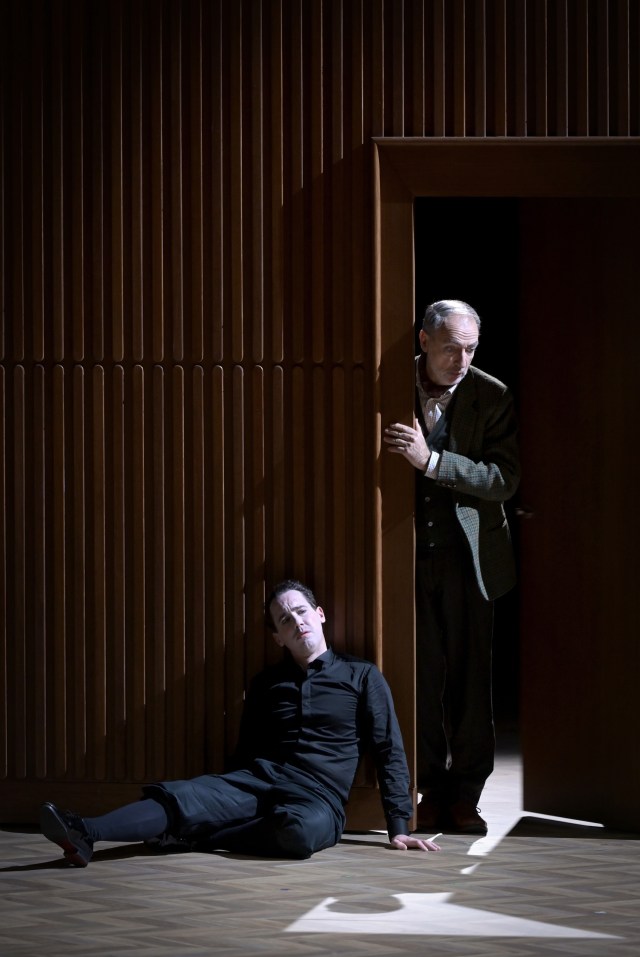
Don Alfonso on the lookout (Laurent Naouri) in front of overwhelmed Ferrando-Sempronio (Cyrille Dubois) C) Vincent Pontet
Long live French singing!
We said the bet to entrust Mozart to a French distribution. It should be added that these French singers are now, like many of their comrades, INTERNATIONAL singers, who are no longer reduced to Bizet and Massenet. And we must also underline the pleasure we had, that we still have, in seeing them grow over the years. Starting with a Vannina Santoni whose Michel Franck, the director of the Théâtre des Champs-Elysées, praised, with emotion and admiration, the already wide range of roles by presenting her, at the end of the performance, with the insignia of Chevalier des Arts and Letters. A very touching Santoni as Fiordiligi fighting to the extreme against her feelings, always charming timbre, perfect highs, when the orchestra does not force her to force her voice: a difficult role because the low notes of the character force her to perilous deviations when she resumes her tessitura.
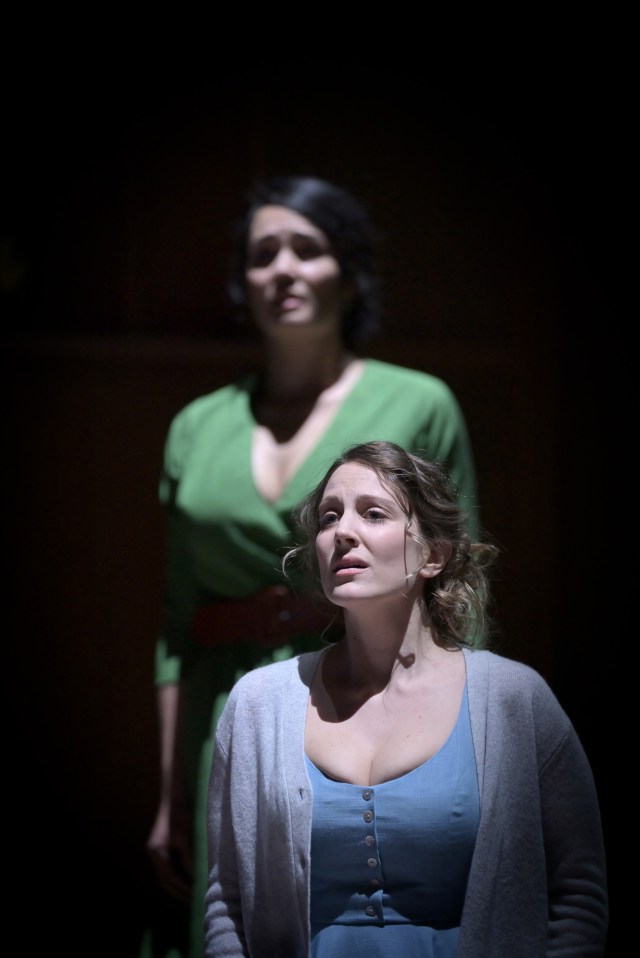
Dorabelle (Gaëlle Arquez) behind Fiordiligi (Vannina Santoni) C) Vincent Pontet
Everyone in their rightful role
La Dorabella by Gaëlle Arquez has the beautiful colors of the singer’s voice and her presence; the complicity that also visibly unites him to Santoni. The character of Dorabella is however less complex than that of her sister. Ferrando-Cyrille Dubois is very moving, with this increasingly particular tenor timbre, almost tenor digrazia, both light and well projected, with an acting talent that asserts itself from role to role.
Florian Sempey surprises us less in Guglielmo, even if he shows just fury in betrayal. The voice is still powerful, the presence remarkable but, here too, the role is less detailed than that of Dubois. Laurent Naouri, meanwhile, delights in Don Alfonso, cunning, frowning eye, crossing the set with the muffled steps of a bogeyman cat, even if some shifts are the ransom. Finally, Laurène Paterno’s timbre will still have to be rounded (the treble is a little sharp) but there is the presence, the energy of the role of Despina, a Despina dressed as a storekeeper then disguising herself as two transvestite characters who came straight from Molière, notary and doctor, where she persists in making her intonations ugly (successfully!).
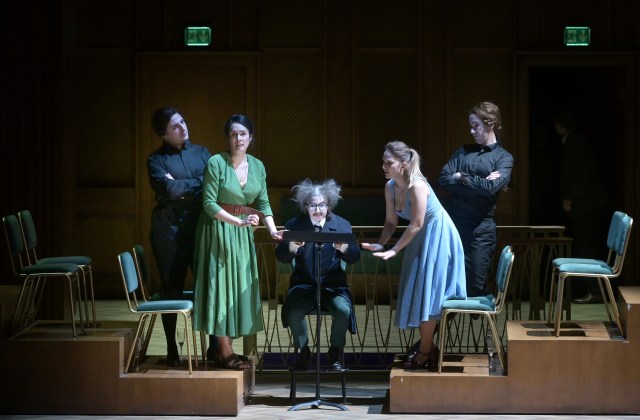
Guglielmo-Tizio (Florian Sempey) and Dorabella (Gaëlle Arquez) / Fiordiligi (Vannina Santoni) and Ferrando-Sempronio (Cyrille Dubois) surround Despina (Laurène Paterno) disguised as a notary C) Vincent Pontet
An energetic leadership
Direction full of energy, tireless, by Emmanuelle Haïm, at the head of a valiant Concert d’Astrée and with fine individualities (the work of the winds is not always comfortable), in particular the pianoforte by Benoît Hartoin . However, Haïm, who imposes fast tempos, will be criticized for sometimes confusing speed and haste, at the risk of endangering certain musicians… and singers.
As for Laurent Pelly, he owes us a revenge.
Cosi fan tutte by Wolfgang Amadeus Mozart, directed by Laurent Pelly, musical direction by Emmanuelle Haïm. Théâtre des Champs-Elysées, Paris, March 12, 14, 16 and 18 at 7:30 p.m., March 20 at 5 p.m.
